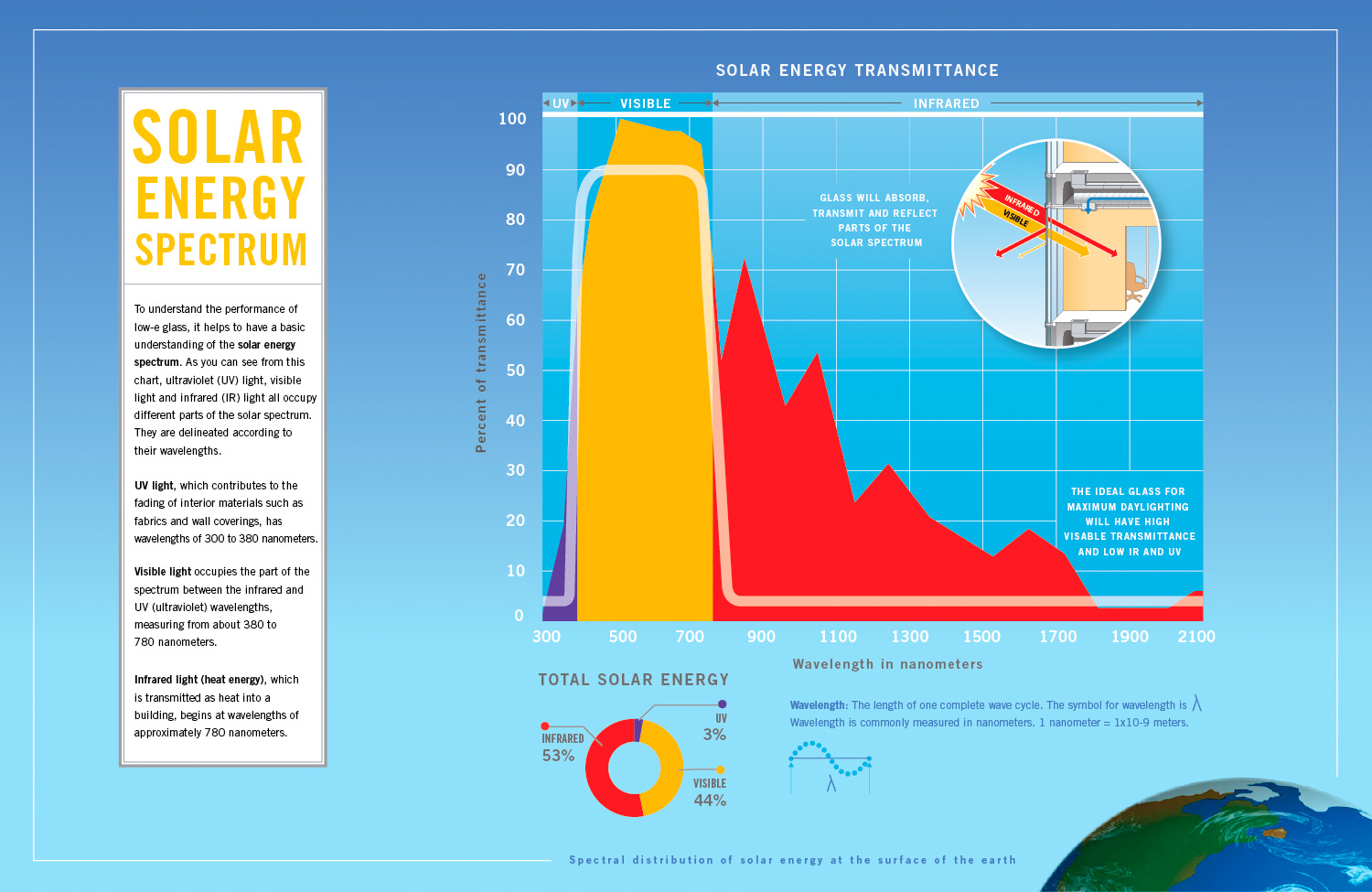Low-emissivity (low-e) glasses are critical to making today’s buildings brighter, more energy-efficient and more sustainable. By controlling solar heat gain and promoting daylighting, they help buildings use less energy for temperature control and lighting, while adding the human benefits associated with outdoor views and more pleasant working and living environments.
Here are five tips to help architects, engineers, and contractors understand and explain the differences among low-e glasses and their impact on building performance:
1. E = Emissivity. Emissivity refers to the relative ability of a material’s surface to radiate energy. Low-e glass has a microscopically thin coating that lowers the emissivity of the glass surface and is engineered to transmit energy from the visible light portion of the solar spectrum (between 380 and 780 nanometers), while reflecting energy from ultraviolet light (310 to 380 nanometers), which causes fading, and infrared light (above 780 nanometers), which makes buildings warmer.
2. Think of a thermos. A thermos works by using a silver lining to continuously reflect and maintain the temperature of the drink it contains. Low-e glasses function according to the same principal, using multiple layers of silver or other low-emissivity materials in the coating to keep heat inside a building or prevent it from entering. Similarly, thermoses and insulating glass units (IGUs) are both designed with air spaces that provide a layer of insulation between the inside and outside.
3. More slivers of silver. Low-e coatings incorporate multiple layers of silver (or other low- emissivity materials) to control the transmission and reflection of heat and light. Recent technical advances now enable glass manufacturers to deposit up to three layers of silver on the glass substrate, which has enhanced the solar control capability of low-e glasses without diminishing their ability to transmit light.
4. Passive for insulation. Passive low-e glasses are usually made using the pyrolitic process, which means the coating is applied while the molten glass ribbon is still on the float line. This produces a “hard” coat that is fused to the glass surface and highly durable, but which has a higher emissivity that a solar-control low-e glass. Passive low-e glasses have decent insulating capabilities, but because of the limitations of metal deposition on the float line, they permit more solar infrared energy (heat) to pass through their coatings and become trapped inside the building. Consequently, passive low-e glasses are often the best choice for cold, heating-dominated climates.
5. Solar control to reduce heat gain. Coatings for solar control, low-e glasses are applied to pre-cut sheets of glass in a vacuum chamber at room temperature. This gives glass manufacturers the ability to deposit more sophisticated coatings (with multiple layers of silver) on the glass substrate, which improves solar control of the infrared (heat) portion of the solar spectrum without substantially diminishing the transmittance of visible light. These coatings are the best choice for hot, cooling-dominated (and moderate) climates. The lower emissivity of solar control low-e glasses also provides better insulating values to maintain the interior temperatures.
To learn more about low-e glass and other topics related to designing, specifying and building with glass, visit the PPG Glass Education Center at http://educationcenter.ppg.
Related Stories
| Aug 11, 2010
American Concrete Institute forms technical committee on BIM for concrete structures
The American Concrete Institute (ACI) announces the formation of a new technical committee on Building Information Modeling (BIM) of Concrete Structures.
| Aug 11, 2010
10 tips for mitigating influenza in buildings
Adopting simple, common-sense measures and proper maintenance protocols can help mitigate the spread of influenza in buildings. In addition, there are system upgrades that can be performed to further mitigate risks. Trane Commercial Systems offers 10 tips to consider during the cold and flu season.
| Aug 11, 2010
Reed Construction Data files corporate espionage lawsuit against McGraw-Hill Construction Dodge
Reed Construction Data (RCD), a leading construction information provider and a wholly-owned subsidiary of Reed Elsevier (NYSE:RUK, NYSE:ENL), today filed suit in federal court against McGraw-Hill Construction Dodge, a unit of The McGraw-Hill Companies, Inc. (NYSE:MHP). The suit charges that Dodge has unlawfully accessed confidential and trade secret information from RCD since 2002 by using a series of fake companies to pose as RCD customers.
| Aug 11, 2010
Jacobs, HOK top BD+C's ranking of the 75 largest state/local government design firms
A ranking of the Top 75 State/Local Government Design Firms based on Building Design+Construction's 2009 Giants 300 survey. For more Giants 300 rankings, visit http://www.BDCnetwork.com/Giants
| Aug 11, 2010
Brad Pitt’s foundation unveils 14 duplex designs for New Orleans’ Lower 9th Ward
Gehry Partners, William McDonough + Partners, and BNIM are among 14 architecture firms commissioned by Brad Pitt's Make It Right foundation to develop duplex housing concepts specifically for rebuilding the Lower 9th Ward in New Orleans. All 14 concepts were released yesterday.
| Aug 11, 2010
NAVFAC releases guidelines for sustainable reconstruction of Navy facilities
The guidelines provide specific guidance for installation commanders, assessment teams, estimators, programmers and building designers for identifying the sustainable opportunities, synergies, strategies, features and benefits for improving installations following a disaster instead of simply repairing or replacing them as they were prior to the disaster.
| Aug 11, 2010
City of Anaheim selects HOK Los Angeles and Parsons Brinckerhoff to design the Anaheim Regional Transportation Intermodal Center
The Los Angeles office of HOK, a global architecture design firm, and Parsons Brinckerhoff, a global infrastructure strategic consulting, engineering and program/construction management organization, announced its combined team was selected by the Anaheim City Council and Orange County Transportation Authority (OCTA) to design phase one of the Anaheim Regional Transportation Intermodal Center.
| Aug 11, 2010
GBCI launches credentialing maintenance program for current LEED APs
The Green Building Certification Institute (GBCI) launched a credentialing maintenance program (CMP) for LEED APs and Green Associates, ensuring that LEED professional credentials will remain relevant and meaningful in a rapidly evolving marketplace.








